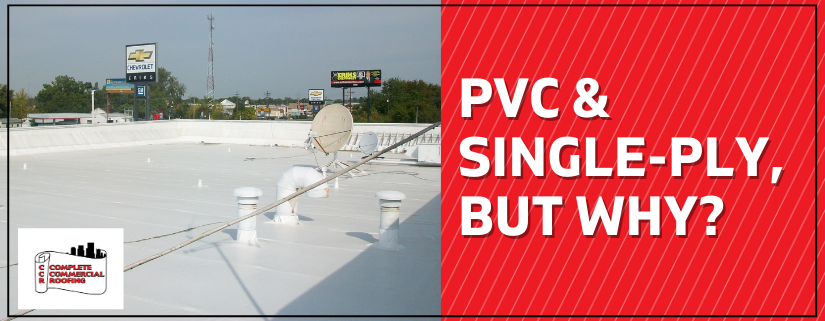An Overview of PVC Commercial Roofing Systems
Polyvinyl chloride – PVC – roofs are in a class of single-ply roofing systems called thermoplastics that also includes TPO.
Single-ply roofing systems are distinguished from built-up roofing which are literally “manufactured” on the rooftop by alternating multiple “plies” of material – reinforcement fabric and bitumen (asphalt). These roofs often have a layer of stone or gravel on top, so are also known as “tar and gravel” roofs.
In contrast, single-ply roofing are sheets of roofing material that are manufactured in a factory, then shipped to the job site for installation. There are several types of single-ply’s on the market, including modified bitumen (evolved from built-up), EPDM (using thermoset chemistry; essentially rubber), and thermoplastics, which include PVC, thermoplastic olefin (TPO) and a few others. One characteristic of thermoplastics is that they melt when heated and re-solidify when they cool. This feature enables thermoplastic roofing membrane sections to be hot-air-welded on the rooftop when installed. Section edges are literally melted together, creating a bond at the seam that’s as strong as the membrane itself.
PVC roofing membranes have a very wide ambient temperature welding window, meaning that they can be effectively installed in very cold conditions. TPO has a much narrower window.
Other features and benefits of PVC roofing systems:
- Today’s PVC roofing membranes are manufactured with a layer of high-density woven scrim laminated between two layers of PVC film that gives the membrane strength and stability and a high degree of puncture resistance.
- PVC roofs are durable and can usually be counted on to provide a long service life on the rooftop. Many systems have been in place for 25 years or more. PVC roofing systems are effective on commercial buildings of all types throughout the US.
- Many PVC membranes are made with recycled materials and several manufacturers offer end-of-life recycling programs. This means that PVC roofs have a smaller environmental impact than other technologies.
- Also reducing environmental impact is PVC’s high reflectivity. On hot summer days, solar energy is reflected away from the building, not transferred into it. This consumes less power by reducing strain on rooftop HVAC units. Also, workers in non-conditioned spaces (e.g. warehouses) are more productive with a reflective roof because the interior is kept cooler on hot days.
These reasons and more should encourage you to consider a PVC roofing system when yours is in need of replacement. Please contact the professionals at Complete Commercial Roofing to discuss why a PVC roof is right for you.









Leave a Reply
Want to join the discussion?Feel free to contribute!